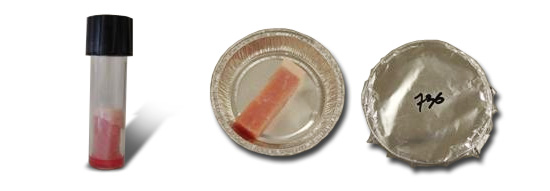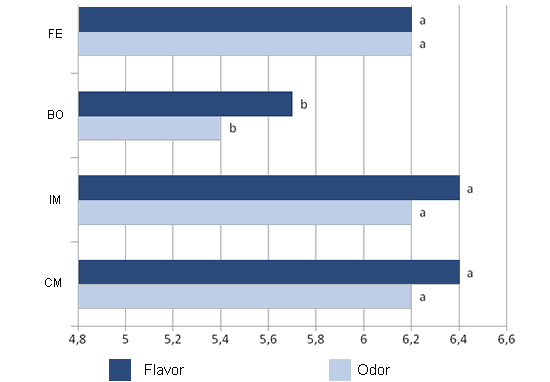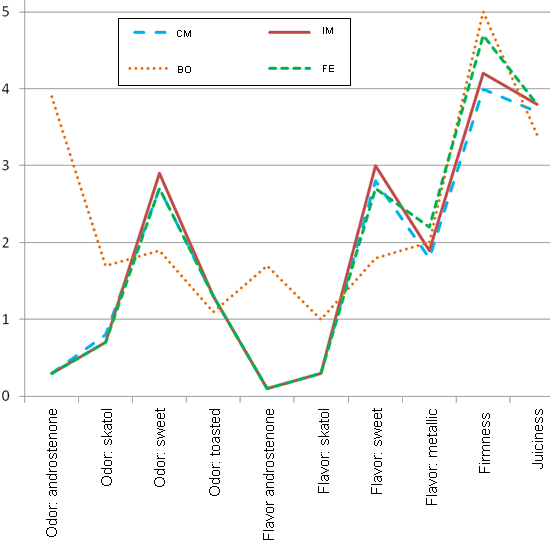Due to the fact that the consumer is the last link in the food chain and, consequently they are the ones who suffer from the problem of boar taint, consumer studies are necessary in order to become familiar with the acceptability of immunocastrated pork meat, compared to other types of meats that can be found on the market; barrow, boar, or female. Likewise, a description by a trained panel can show us the characteristics of different meats and help to explain consumer reactions.
The objective of this work is to obtain a sensory description by way of a trained panel and determine acceptability on behalf of the consumer, of pork meat from boars, immunocastrated males, surgically castrated males, and females.
For the trial the loin (Longissimus thoracis) of 24 females (FE), 24 Boars (BO), 23 surgically castrated males (CM) and 24 immunocastrated males (IM) of a Pietrain x cross (Duroc x Landrace) were used. Immunocastration was carried out with two doses, the first at 77 days and the second at 146 days, about 4 weeks before slaughter. The animals were raised and slaughtered at the IRTA center in Monells.
The loins were cut into slices of 1,5 x 1,5 cm, with 3 cm of subcutaneous fat. These pieces were cooked in the oven and evaluated by a trained panel as well as consumers. For the trained panel the samples were cooked within a glass tube (Figure 1a) and for the consumers they were cooked in an aluminum container (Figure 1b).

| (a) | (b) |
201 consumers were selected (table 1), participating in 20 sessions. Each consumer evaluated 4 samples, one of each type of meat, and they were only told they would be evaluating pork meat. They evaluated the acceptability of smell and taste on a scale of 9 points, 1 being strongly dislike and 9 being strongly like.
Table 1: Consumers participating in the study.
| Age/Gender | Males | Females | Total |
| 18-25 | 20 | 14 | 34 |
| 16-40 |
35 | 31 |
66 |
| 41-60 |
32 | 34 |
66 |
| 61-77 |
17 | 18 |
35 |
| Total (n) |
104 |
97 |
201 |
As far as the trained panel is concerned, 8 panelists evaluated 4 samples per session, one of each type. For each sample the following attributes were graded on a continual scale from 1 to 10:
- Odor: androstenone, skatol, sweet and toastedFigure 2 shows the scores of acceptability of odor and flavor on the part of the consumers. We can see that the BO loins received significantly lower (p<0,05) scores than the other evaluated loins. Likewise, no significant differences were found in the scores on odor and flavor in the loins of the FE, IM and CM.
- Flavor: androstenone, skatol, sweet and metallic
- Texture: firmness and juiciness

Figure 2. Odor and flavor scores according to the type of meat evaluated (FE: female, BO: boar, CM: castrated male; IM: immunocastrated male).
Regarding the results of the trained panel (figure 3), these show the BO meat as having significantly higher odor and flavor scores of androstenone y skatol (p<0, 05) than the other meats. Likewise, there BO meat had significantly lower scores than the others (p<0,05) in odor and flavor sweet and juiciness.

Figure 3. Scores of the different attributes odor and flavor by the trained panel according to the type of meat: FE: female, BO: boar, CM: castrated male; IM: immunocastrated male).
Correlations among the attributes evaluated by the trained panel and the acceptability of the meat by the consumers show that upon increasing the scores of androstenone and skatol odor by the panel, the acceptability of the odor on the part of the consumers diminishes (r=-0,50 for androstenone and -0,22 for skatol). Likewise, when the androstenone and skatol flavor score was increased by the panel, the acceptability of the flavor on behalf of the consumers also decreased (r=-0,42 for both compounds).
Conclusion
Within the conditions of the experiment carried out we can conclude that the meat of immunocastrated males is noted to be similar to that of the meat of females and surgically castrated males, and has less taste of androstenone and skatol. Likewise, the immunocastrated pigs’ meat is more accepted by consumers than boar meat and is accepted at the same level as female pork meat and surgically castrated male pig meat.




